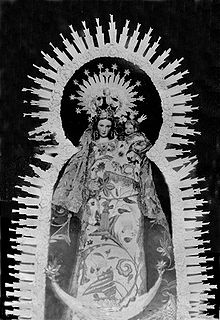Virgin of Miracles
On June 14, 1993, it was crowned by the Pope John Paul II, who named it «Mother of Spain and the Americas (Spanish: Madre de España y América)».
The body of the sculpture is one piece, although with some minor attachments in the posterior due to some imperfections suffered during its history; it rests atop a 5 centimeter pedestal with elongated lines.
[6] It has a unique form of shifting the hips to sustain the baby in its left arm, which is characteristic of the type of sculpture to which it belongs.
In her right arm the Virgin carries a Pomegranate, placed there in a restoration done in 1937, after the damage suffered during the Spanish Civil War, and which replaced the Lilium she initially held.
Examples of this type of imagery and of similar style, can be found in the "Capilla de los Alabastros" in the Seville Cathedral or in Church of San Lorenzo[11] of the same city.
Also at Palos de la Frontera, in the Parish of San Jorge there is an Image of Santa Ana sculpted in the same material.
[6] For centuries, the sculpture was polychrome, dressed in fine clothing, and adorned with precious stones according to all the various reports made on its restorations,[13] wills, documentation, and engravings stored at the monastery and at the archives[14] of the French order in the Provincia Beltica.
Finally after the restoration done in 1937, it was decided to eliminate the polychrome from the image and in 1938 it was returned back to her monastery[16] in the original form in which it was sculpted.
Among those buildings known for its artistic qualities are the Gothic-Mudéjar church, the decorated stays containing frescoes by Daniel Vasquez Diaz, the cloister, and the museum housing numerous objects commemorating the Discovery of the Americas.
The majority are recognized in the 1714 codex of Fray Felipe de Santiago,[3] where the traditions and legends of the area and time period are documented along with historical data.
[3] According to legend, the image would have been sculpted in the beginnings of Christianity by St. Luke[27][28] and brought to the port of Palos in the year 333 by a Libyan sailor, Constantino Daniel.
And Macarius told Constantino that he would intercede with God, to see if it would please Him to give him the image of the Virgin Mary that was at Mount Zion, which had been painted by Saint Luke.
Under the imminent fear of having their patron saint desecrated or destroyed by the Saracens, two priests, Anselmo Gómez and Leandro Alberto, claimed that they had received a revelation commanding them to hide the image at sea until God saw a better moment to uncover it.
However, according to the legend, the bone was cast repeatably onto the floor, it was never permitted to stay in the spot previously occupied by the Virgin, an act which the followers of the prophet would have attributed to a supposed Christian enchantment.
Intervention was necessary by the overseeing abbot of the convent, whose opinion was respected by both sides, to finally resolve the issue; the Virgin was deposited in a boat near where she had appeared, leaving her alone without any crewmen, to see where the waves would take her.




